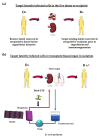HCMV Antivirals and Strategies to Target the Latent Reservoir
- PMID: 34062863
- PMCID: PMC8147263
- DOI: 10.3390/v13050817
HCMV Antivirals and Strategies to Target the Latent Reservoir
Abstract
Human cytomegalovirus (HCMV) is a ubiquitous human herpesvirus. In healthy people, primary infection is generally asymptomatic, and the virus can go on to establish lifelong latency in cells of the myeloid lineage. However, HCMV often causes severe disease in the immunosuppressed: transplant recipients and people living with AIDS, and also in the immunonaive foetus. At present, there are several antiviral drugs licensed to control HCMV disease. However, these are all faced with problems of poor bioavailability, toxicity and rapidly emerging viral resistance. Furthermore, none of them are capable of fully clearing the virus from the host, as they do not target latent infection. Consequently, reactivation from latency is a significant source of disease, and there remains an unmet need for treatments that also target latent infection. This review briefly summarises the most common HCMV antivirals used in clinic at present and discusses current research into targeting the latent HCMV reservoir.
Keywords: F49A-FTP; antiviral; human cytomegalovirus; latency; latent reservoir; shock and kill; transplant.
Conflict of interest statement
The authors declare no conflict of interest.
Figures

Similar articles
-
Latency-Associated Expression of Human Cytomegalovirus US28 Attenuates Cell Signaling Pathways To Maintain Latent Infection.mBio. 2017 Dec 5;8(6):e01754-17. doi: 10.1128/mBio.01754-17. mBio. 2017. PMID: 29208743 Free PMC article.
-
Advances in the treatment of cytomegalovirus.Br Med Bull. 2019 Sep 19;131(1):5-17. doi: 10.1093/bmb/ldz031. Br Med Bull. 2019. PMID: 31580403 Free PMC article.
-
Ex vivo treatment of cytomegalovirus in human donor lungs using a novel chemokine-based immunotoxin.J Heart Lung Transplant. 2022 Mar;41(3):287-297. doi: 10.1016/j.healun.2021.10.010. Epub 2021 Oct 25. J Heart Lung Transplant. 2022. PMID: 34802874
-
Human cytomegalovirus latent infection and associated viral gene expression.Future Microbiol. 2010 Jun;5(6):883-900. doi: 10.2217/fmb.10.58. Future Microbiol. 2010. PMID: 20521934 Review.
-
Early inhibitors of human cytomegalovirus: state-of-art and therapeutic perspectives.Pharmacol Ther. 2011 Sep;131(3):309-29. doi: 10.1016/j.pharmthera.2011.04.007. Epub 2011 Apr 28. Pharmacol Ther. 2011. PMID: 21570424 Free PMC article. Review.
Cited by
-
EZH2-Myc driven glioblastoma elicited by cytomegalovirus infection of human astrocytes.Oncogene. 2023 Jun;42(24):2031-2045. doi: 10.1038/s41388-023-02709-3. Epub 2023 May 5. Oncogene. 2023. PMID: 37147437 Free PMC article.
-
Strigolactones, from Plants to Human Health: Achievements and Challenges.Molecules. 2021 Jul 29;26(15):4579. doi: 10.3390/molecules26154579. Molecules. 2021. PMID: 34361731 Free PMC article. Review.
-
Assessment of Covalently Binding Warhead Compounds in the Validation of the Cytomegalovirus Nuclear Egress Complex as an Antiviral Target.Cells. 2023 Apr 14;12(8):1162. doi: 10.3390/cells12081162. Cells. 2023. PMID: 37190072 Free PMC article.
-
40 Years after the Registration of Acyclovir: Do We Need New Anti-Herpetic Drugs?Int J Mol Sci. 2022 Mar 22;23(7):3431. doi: 10.3390/ijms23073431. Int J Mol Sci. 2022. PMID: 35408788 Free PMC article. Review.
-
Cytomegalovirus pneumonia with intermittent pulmonary hemorrhage leading to asphyxia death: a case report and literature review.Virol J. 2024 Jun 5;21(1):131. doi: 10.1186/s12985-024-02399-7. Virol J. 2024. PMID: 38840200 Free PMC article. Review.
References
Publication types
MeSH terms
Substances
Grants and funding
LinkOut - more resources
Full Text Sources
Other Literature Sources
Medical

